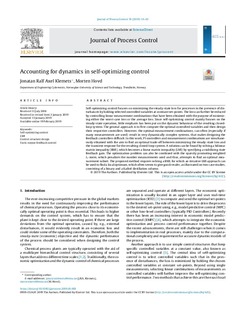| dc.contributor.author | Klemets, Jonatan Ralf Axel | |
| dc.contributor.author | Hovd, Morten | |
| dc.date.accessioned | 2020-01-20T09:00:16Z | |
| dc.date.available | 2020-01-20T09:00:16Z | |
| dc.date.created | 2019-04-30T13:58:40Z | |
| dc.date.issued | 2019 | |
| dc.identifier.citation | Journal of Process Control. 2019, 76 15-26. | nb_NO |
| dc.identifier.issn | 0959-1524 | |
| dc.identifier.uri | http://hdl.handle.net/11250/2636927 | |
| dc.description.abstract | Self-optimizing control focuses on minimizing the steady-state loss for processes in the presence of disturbances by holding selected controlled variables at constant set-points. The loss can further be reduced by controlling linear measurement combinations that have been obtained with the purpose of minimizing either the worst-case loss or the average loss. Since self-optimizing control mainly focuses on the steady-state operation, little emphasis has been put on the dynamic behaviour of the resulting closed-loop system. The general approach is to first compute the optimal controlled variables and then design their respective controllers. However, the optimal measurement combinations, can often (especially if many measurements are used) result in very dynamically complex systems, that makes designing the feedback controllers difficult. In this work, PI controllers and measurement combinations are simultaneously obtained with the aim to find an optimal trade-off between minimizing the steady-state loss and the transient response for the resulting closed-loop system. A solution can be found by solving a bilinear matrix inequality (BMI), which becomes a linear matrix inequality (LMI) by specifying a stabilizing state feedback gain. The optimization problem can also be combined with the sparsity promoting weighted l1-norm, which penalizes the number measurements used and thus, attempts to find an optimal measurement subset. The proposed method requires solving a BMI, for which an iterative LMI approach can be used to find a local optimum, which often seems to give good results, as illustrated on two case studies, consisting of a binary and a Kaibel distillation column. | nb_NO |
| dc.language.iso | eng | nb_NO |
| dc.publisher | Elsevier | nb_NO |
| dc.rights | Navngivelse 4.0 Internasjonal | * |
| dc.rights.uri | http://creativecommons.org/licenses/by/4.0/deed.no | * |
| dc.title | Accounting for dynamics in self-optimizing control | nb_NO |
| dc.type | Journal article | nb_NO |
| dc.type | Peer reviewed | nb_NO |
| dc.description.version | publishedVersion | nb_NO |
| dc.source.pagenumber | 15-26 | nb_NO |
| dc.source.volume | 76 | nb_NO |
| dc.source.journal | Journal of Process Control | nb_NO |
| dc.identifier.doi | 10.1016/j.jprocont.2019.01.003 | |
| dc.identifier.cristin | 1694778 | |
| dc.description.localcode | © 2019 The Authors. Published by Elsevier Ltd. This is an open access article under the CC BY license(http://creativecommons.org/licenses/by/4.0/). | nb_NO |
| cristin.unitcode | 194,63,25,0 | |
| cristin.unitname | Institutt for teknisk kybernetikk | |
| cristin.ispublished | true | |
| cristin.fulltext | preprint | |
| cristin.qualitycode | 2 | |

